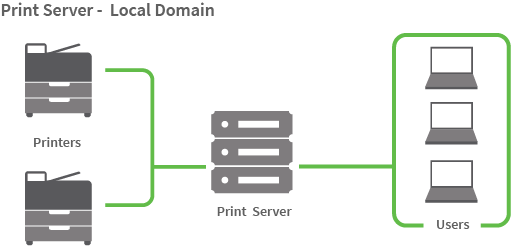This topic describes how to use Print Deploy to clone classic server-hosted print server queues. Some benefits of using a print server are centralized driver management and PaperCut features like Print Archiving and Find-Me Printing.
One drawback is that this assumes you already have a domain environment with a print server, and that users’ computers are authenticated and already able to add print queues using the server.

The high-level steps are:
- Set up the print queues on the reference computer
- Clone the print queue details into Print Deploy
- Connect print queues to a zone
Step 1: Set up the print queues on the reference computer
A reference computer is a Windows and/or Mac computer where you set up and test the print queues before deploying them to the users. It’s also where you set the default settings for print queues (for example, grayscale, 2-sided) and capabilities (for example, finishing options like stapling and hole punching). It should not be a print server.
Windows drivers often support multiple versions of Windows, for example, Windows 10 and Windows 8. PaperCut NG/MF automatically detects which versions of Windows the driver supports and displays them in its Admin web interface.
-
On the designated reference computer, install the network printers that you want to deploy to your users. In other words, pretend that you are setting up this computer for a user.
-
Configure the printer defaults for each queue.
- Windows: Printer Properties > Advanced > Printing Defaults
- Mac: via the CUPS Web Interface, available via:
http://localhost:631/orhttp://servername:631/
-
For advanced finishing options, configure the capabilities under:
- Printer Properties > General > Preferences
- Printer Properties > Advanced > Printing Defaults
- Some printer drivers may have settings available in the following tabs:
- Printer Properties > Device Settings (example: hp)
- Printer Properties > Configuration (example: fuji-xerox)
- Printer Properties > Optional Settings (example: epson)
-
Test that printing works on each print queue.
Step 2: Run the Cloner to import printers
-
On the reference computer, log in to PaperCut NG/MF (which is installed and running elsewhere on the network).
-
Select Enable Printing > Print Deploy. The Print Deploy page is displayed.
-
In the right panel, do one of the following:
- If this is the first time you’re using Print Deploy, click the Download cloner tool button for your operating system.
- If you already have print queues installed, click Add or update; then click the download button for your operating system
- The cloner tool (.exe, .dmg) is downloaded with the PaperCut NG/MF server address embedded into its filename.
-
On the Reference computer, run the cloner tool.
The cloner tool bundles all of the print queues, printer drivers, default settings (for example, grayscale, 2-sided) and capabilities (for example, finishing options like stapling and hole punching) and uploads the bundle automatically to the Application Server.
All of the print queues are displayed in the Print queues list at the right of the Print Deploy page.
Step 3: Connect print queues to a zone
A zone is a location defined by an IPv4 address range, for example, an office, branch, or campus. It also include user groups to help define who can access the printers in that zone.
By default Print Deploy has one zone, called Everyone, that deploys print queues to all computers and all groups in the network. And of course you can add as many of your own zones as required.
-
Click Zones, then in the Your zones list, select the zone you want to connect printers to.
If you need to add a new zone first, take a look at how to add zones and user groups to Print Deploy .
-
In the Print queues list, select which printers you want to be automatically installed on the users’ computers; then click Connect to zone. They are added to the list of print queues for that zone.
-
If required, add print queues to the zone that you want to make optional for users to install on their computer. They can install them via the Add printers tab in their Print Deploy client.
a. In the Print queues list, select which printers you want to make optional for users to install.
b. At the bottom of the list of printers, select the Optional install checkbox.
c. Click Connect to zone. They are added to the list of print queues for that zone.
What’s next?
If the Print Deploy client has already been installed on some computers, click Save and deploy. The print queues will be automatically installed on the computers within 15 minutes. (This time is configurable ).
Otherwise, decide if you want to:
- make any configuration changes to Print Deploy (optional)
- make any security enhancements (optional)
- jump straight to rolling out the Print Deploy client .




Comments